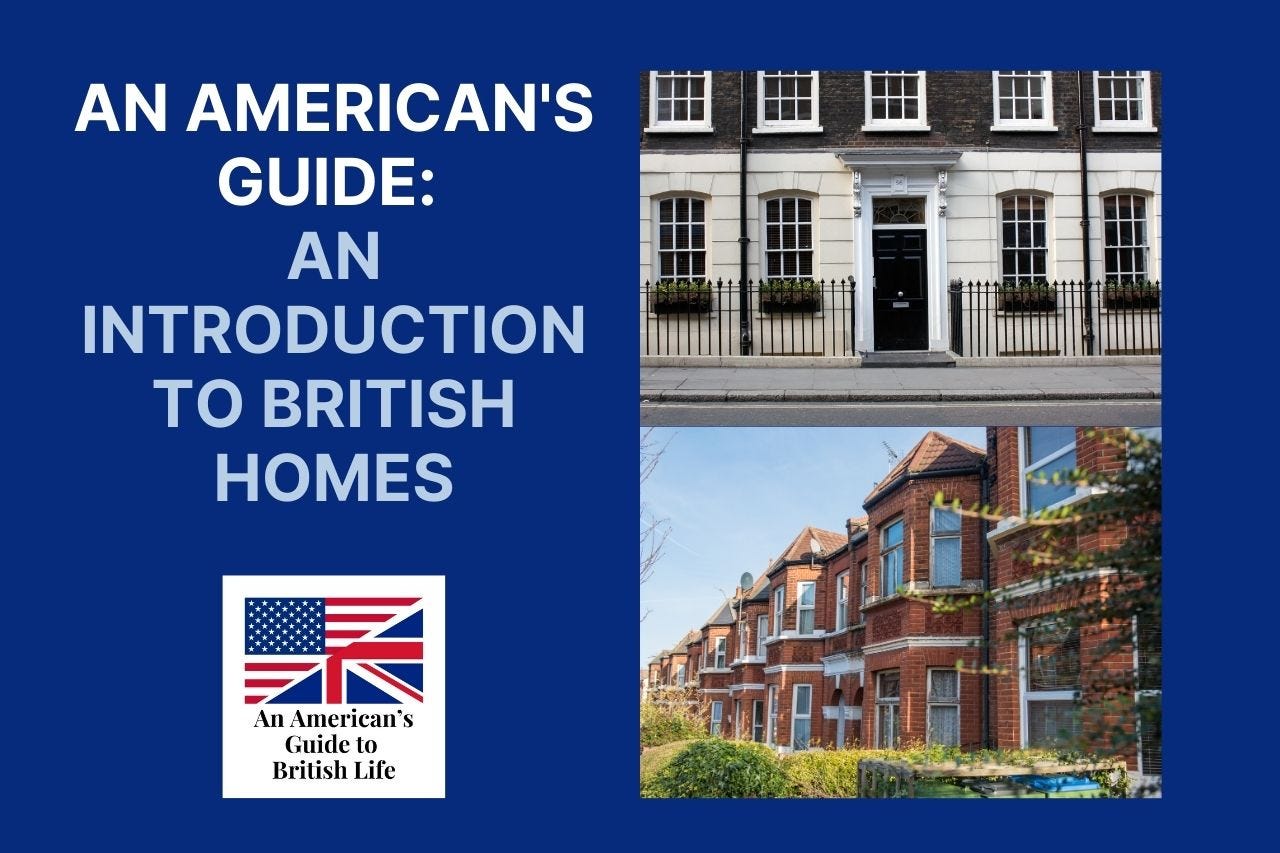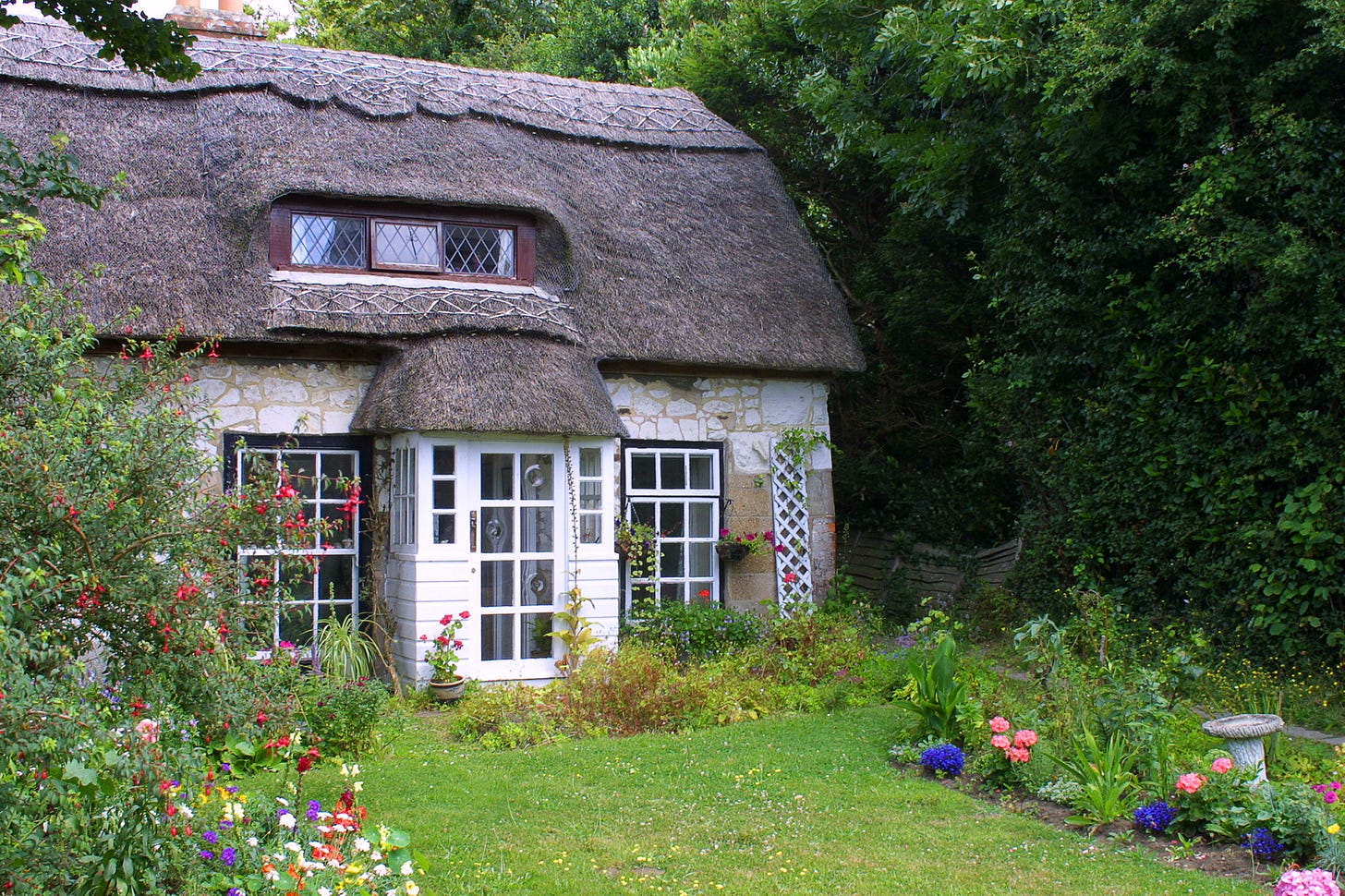An American's Guide: An Introduction to British Homes
Where Washing Machines Live in Kitchens
Welcome to An American's Guide to British Life - my lighthearted celebration of British culture! As an American living in the UK for the past three years, I love exploring the delightful cultural differences and similarities that make life here so interesting. These articles are written with affection and humor, never judgement and always with respect.
When I moved to the UK to join my British partner in their terraced house, I thought I was prepared for the differences. After all, how different could homes be in two English-speaking countries? Then I discovered the washing machine in the kitchen, watched cars engage in complex parking negotiations outside my window, and learned that what British people proudly call "period features" is their way of saying "things that are really old but we've decided that makes them charming."
Like many Americans, I'd grown up with walk-in closets, massive fridges, and central air conditioning. I was about to discover that none of these were standard features in the UK. Instead, I was entering a world where every room held a new surprise.
House Hunting Culture Shock
If you're an American preparing to move to Britain, prepare for a radical recalibration of your space expectations. The average new American home is about 2,500 square feet. The average British "new build" (that's what they call newly constructed homes here) is around 800 square feet.
First, you'll need to learn the British house-type vocabulary, which is far more specific than American terminology:
A detached house stands completely alone - what Americans would typically call a single-family home. These are often the most expensive option in the UK, where space is at a premium.
A semi-detached house or "semi" shares one wall with a neighbor, like half of a duplex in American terms. These are incredibly common in British suburbs.
A terraced house (where I live) shares walls on both sides with neighbors, like books on a shelf. Americans might call these row houses or townhouses.
An end-terrace is the coveted house at the end of a terrace, sharing only one wall and sometimes featuring windows on three sides.
A bungalow is a single-story home - same word as in America, but much rarer and often occupied by retirees.
A flat is an apartment, usually in a converted house or purpose-built block.
A manor house is a historic, usually large country house - think Downton Abbey, but most have been divided into flats or converted into hotels.
A cottage is a traditional, usually small house, often in a rural setting with period features like exposed beams or a thatched roof.
Many British people live in older homes - Victorian (1837-1901), Edwardian (1901-1910), or even older. These homes tend to have higher ceilings, thicker walls, and more of those charming "period features," but they also come with their own quirks, some of which we'll look at in future articles.
The Name Game
One of the first things that confused me about British homes was discovering that many houses have names instead of, or in addition to, numbers. While Americans are used to straightforward numerical addresses, you might find yourself looking for "Rose Cottage," "The Willows," or "Dunroamin" (a popular pun that never gets old, apparently).
These names aren't just quaint traditions - they're official parts of the address and can make finding a specific house feel like a treasure hunt. Some houses have both names and numbers, but the name might be the one everyone actually uses.
And good luck if you're trying to find a house name on a dark evening - they're often displayed on small plaques or carved into stone, requiring either local knowledge or a very good flashlight (or torch if you're British) to locate.
The Great British Parking Puzzle
One of the first shocks for Americans isn't even inside the house - it's figuring out where to put your car. While Americans expect at least a driveway, many British homes, especially terraced houses, rely entirely on street parking. This leads to the distinctly British phenomenon of territorial parking - an intricate social dance where spots aren't officially assigned, but heaven help you if you park in front of someone else's house without good reason.
The unwritten rules of street parking could fill their own article. There's the obligation to leave enough space for others (but not so much that another car could fit), the silent judgment of parking across from someone's driveway, and the sacred understanding that if someone has gone to the trouble of putting cones or bins out to "reserve" their spot while they're at work, you simply don't move them.
If you're lucky enough to have a garage (pronounced "GAR-idge"), don't expect to fit an American-sized car in it. British garages were designed for classic Minis, not modern SUVs, and they're often repurposed as storage spaces - a precious commodity in British homes.
Kitchen Culture Shock
Perhaps nothing says "British home" quite like finding the washing machine in the kitchen. Yes, you read that right - in the kitchen, right next to the dishwasher, probably under the counter where Americans would expect to find extra cabinet space. The reasoning behind this goes deeper than just tradition - in most British homes, especially terraced houses, the bathroom is typically located directly above the kitchen, concentrating all the main plumbing in one vertical strip of the house.
The refrigerator follows the same space-saving philosophy. What Americans consider a "normal" fridge would look comically oversized in a British kitchen. British fridges are what Americans would consider "apartment-sized" or even "mini" - reflecting a different shopping culture where people tend to buy fresh food more frequently.
But while some appliances are minimized, others are given pride of place. The electric kettle is non-negotiable. It's often the first appliance purchased for a new home and occupies a permanent spot on the counter. Even if the house is gutted for remodeling - if there's an electric outlet working, you can bet there'll be a kettle attached!
Essential Kitchen Vocabulary
The stovetop is called a "hob," which sounds like something out of a fantasy novel (and everyone seems to have a favorite burner)
"Grill" refers to what Americans call a "broiler" (the heating element at the top of the oven)
"Tap" instead of "faucet"
"Worktop" instead of "counter" or "countertop"
"Extractor" or "extractor fan" instead of "range hood"
"Tea towel" instead of "dish towel"
"Washing up liquid" instead of "dish soap"
"Kitchen roll" instead of "paper towels"
A pantry is usually called a "larder," though both terms are used (and not many houses have either!)
Essential British-American Housing Dictionary
Living in a British home requires learning an entirely new vocabulary. Here's your guide to the basics:
Room Names and General Terms
Floor numbering will mess with your head. The "first floor" in Britain is what Americans call the second floor. What we call the first floor, Brits call the ground floor.
The living room might be called a reception room, sitting room, or lounge. In older houses, you might encounter multiple "reception rooms," which is just a fancy way of saying "rooms where you can put a sofa."
What Americans call a yard, Brits call a garden - even if it's just a patch of grass with a lone flower pot. Gardens are serious business here, even when there's not much actual gardening happening.
What Brits generally call a yard is more like a small walled outdoor space, usually with concrete floor/paving slabs at the back of a terraced house.
Bathroom Talk
Never ask for the "restroom" - that's a dead giveaway you're American. Instead, you'll hear:
"Loo" - The most casual and common term
"Toilet" - Perfectly acceptable in the UK
"WC" (water closet) - Often used in formal settings
"Bathroom" - Usually only if it actually contains a bath
Forget about describing bathrooms as "full" or "half" baths like we do in America. In British property listings, you'll instead see things like "separate WC" or "downstairs loo."
Home Systems and Features
"Central heating" often just means radiators (not forced air/ducts like in the US)
Most houses have a 'combi-boiler' that provides both heating and hot water
Some older houses have a separate hot water tank with an immersion heater
The "airing cupboard" is the warm cupboard around the hot water tank
Other Home Features
What Americans call baseboards, Brits call skirting boards.
A cupboard is what we'd call a closet, and built-in cupboards are "fitted wardrobes."
The basement is the cellar, and the attic is the loft.
More British Home Adventures Await...
This is just the beginning of understanding British homes. In future articles, we'll explore the mysteries of British windows (and why they don't have screens), the complex world of doors and their many peculiarities, and why having neighbors with spare keys isn't just nice - it's essential for survival.
Have you experienced your own joys and puzzles of British homes? Whether you're an American trying to understand why your washing machine lives in your kitchen, or a Brit who's discovered that your normal is someone else's bizarre, I'd love to hear your stories. Share your experiences in the comments below!
See you next Sunday!
Marianne




Brit surveyor here. Good guide. Remember the UK is tiny compared to the vast swathes of the USA. Land is at a premium so homes are correspondingly smaller. There is an effort to improve public transport especially in cities so households don't need a car.
The UK is rainy and our domestic cleaning battle is against condensation and mold especially in most new build homes that have no bathroom window and rely on vents with inadequate & noisy fans.
Aside from plumbing, there are three other reasons the washing machine/dryer is located in the kitchen. 1. To reduce the lifting of these heavy items upstairs 2. Reduce the risk of flooding the kitchen downstairs if the washer breaks down and 3, being able to hang said laundry on the washing line in the garden where it air dries, depriving fat cat Utility CEOs of their profits from excessive use of the dryer. The back door is usually in the kitchen. Sometimes we are fortunate enough to have a utility room similar to USA 'Boot Room' with laundry appliances including a ceiling airer rack. If large enough this room accommodates muddy boots, wet umbrellas or damp dog.
As a Brit who lives in London in a semi with no off-street parking, a downstairs loo and wardrobes but no closets, I'm feeling like an anthropological curiosity.
I think I must move my washing machine back into the kitchen.
Thank you for this. You made me laugh.